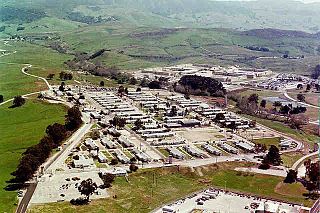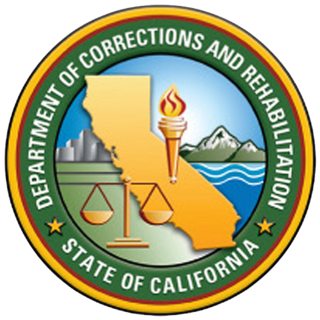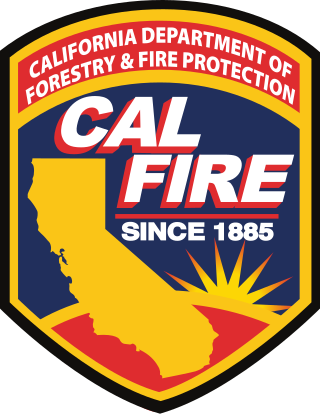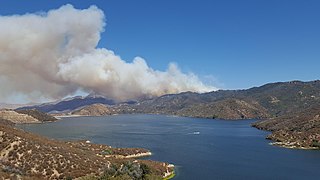
Folsom California State Prison is a California State Prison in Folsom, California, U.S., approximately 20 miles (32 km) northeast of the state capital of Sacramento. It is one of 34 adult institutions operated by the California Department of Corrections and Rehabilitation.

California Men's Colony (CMC) is a male-only state prison located northwest of the city of San Luis Obispo, San Luis Obispo County, California, along the central California coast approximately halfway between Los Angeles and San Francisco.

The California Department of Corrections and Rehabilitation (CDCR) is the penal law enforcement agency of the government of California responsible for the operation of the California state prison and parole systems. Its headquarters are in Sacramento.

California Institution for Men (CIM) is a male-only state prison located in the city of Chino, San Bernardino County, California. It is often colloquially referenced as "Chino". In turn, locals call the prison "Chino Men's" or just "Men's" to avoid confusion with the city itself.

The California Department of Forestry and Fire Protection is the fire department of the California Natural Resources Agency in the U.S. state of California. It is responsible for fire protection in various areas under state responsibility totaling 31 million acres, as well as the administration of the state's private and public forests. In addition, the department provides varied emergency services in 36 of the state's 58 counties via contracts with local governments. The department's current director is Joe Tyler, who was appointed March 4, 2022, by Governor of California Gavin Newsom.

Avenal State Prison (ASP) is a male-only state prison in the city of Avenal, Kings County, California, United States.

California State Prison, Centinela (CEN) is a male-only state prison located in Imperial County, California, approximately 20 miles (32 km) from Imperial and El Centro. The facility is sometimes referenced Centinela State Prison.

California Correctional Center (CCC) was a state prison in the city of Susanville in Northern California. It was a minimum-security facility.

California Correctional Institution (CCI) is a supermax state prison in the city of Tehachapi in southern California. CCI is sometimes referred to as "Tehachapi prison" or "Tehachapi". As stated by the California Department of Corrections and Rehabilitation, its overall mission is "to incarcerate and control felons, while providing the opportunity for meaningful work, training and other programs. The prison provides programs for those inmates who are willing to work and participate fully in available programs."

California State Prison, Sacramento (SAC) is a male-only state prison located in the city of Folsom, in Sacramento County, California. The facility is also referenced as Sacramento State Prison, CSP-Sacramento, CSP-SAC, and occasionally, New Folsom or New Folsom Prison which was its official name prior to October 1992.

The California State Prison System is a system of prisons, fire camps, contract beds, reentry programs, and other special programs administered by the California Department of Corrections and Rehabilitation (CDCR) Division of Adult Institutions to incarcerate approximately 117,000 people as of April 2020. CDCR owns and operates 34 prisons throughout the state and operates 1 prison leased from a private company.
Correctional Training Facility (CTF), commonly referenced as Soledad State Prison, is a state prison located on U.S. Route 101, 5 miles (8.0 km) north of Soledad, California, adjacent to Salinas Valley State Prison.

Sierra Conservation Center (SCC) is a 420-acre (170 ha) state prison located in Tuolumne County, California, near the unincorporated community of Jamestown. Programs offered to prisoners include education, firefighting training, and sewing.

Wasco State Prison-Reception Center (WSP) is a 634-acre (257 ha) state prison located in Wasco, Kern County, California.
The California Prison Industry Authority (CALPIA) manages over 100 manufacturing, service, and consumable industries within the 35 California Department of Corrections and Rehabilitation (CDCR) institutions. It is overseen by the 11-member Prison Industry Board, which is chaired by the CDCR Secretary. CALPIA has more than 8,000 offender assignments in career technical education programs, manufacturing, agricultural, consumable, and service enterprises. CALPIA's administration offices are in Folsom, CA.

In the United States, penal labor is a multi-billion-dollar industry. Annually, incarcerated workers provide at least $9 billion in services to the prison system and produce more than $2 billion in goods. The industry underwent many transitions throughout the late 19th and early and mid 20th centuries. Legislation such as the Hawes-Cooper Act of 1929 placed limitations on the trade of prison-made goods. Federal establishment of the Federal Prison Industries (FPI) in 1934 revitalized the prison labor system following the Great Depression. Increases in prison labor participation began in 1979 with the formation of the Prison Industry Enhancement Certification Program (PIECP). The PIECP is a federal program first authorized under the Justice System Improvement Act of 1979. Approved by Congress in 1990 for indefinite continuation, the program legalizes the transportation of prison-made goods across state lines and allows prison inmates to earn market wages in private sector jobs that can go towards tax deductions, victim compensation, family support, and room and board.

The Pilot Fire was a wildfire that burned near Silverwood Lake in San Bernardino County, California. The fire started at about 12:10 pm on Sunday, August 7, 2016, near the Miller Canyon OHV area off California State Route 138.

California Health Care Facility (CHCF) is a state prison for incarcerated patients with long-term medical needs or acute mental health needs. The prison is located in Stockton, California, on the site of the former Karl Holton Youth Correctional Facility. Incarcerated people of all security levels are treated at the facility.

Incarceration in California spans federal, state, county, and city governance, with approximately 200,000 people in confinement at any given time. An additional 55,000 people are on parole.












